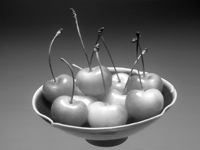
Features
Production
Research
Cornell releases four new stone fruit cultivars
four new stone fruit cultivars
April 23, 2008 By N. Abbott
Fruit breeders at Cornell University recently released two new cherries and two new plums.
Fruit breeders at Cornell University recently released two new cherries and two new plums. The four new varieties, which are primarily for the processing market, were developed and tested by Robert L. Andersen, director of the stone fruit breeding program at Cornell, and professor of horticultural sciences.
“BlackYork (Haas cultivar – NY 1725) is a mid-season, dark-fleshed, sweet cherry that is well adapted to humid climates,” said Andersen, who retired as Cornell’s stone fruit breeder in 2004. “The skin is glossy black, and the fruit of medium size and firmness.” Although primarily a processing sweet cherry well suited for use in cherry yoghurts, BlackYork has also performed well in pick-your-own operations as a fresh-market cherry. “It is a reliable cropper that sets good quality fruit on rugged trees,” said Andersen. BlackYork can pollenize Emperor Francis, Kristin, Ulster, and BlushingGold, the other new cherry release from Cornell.
 |
| Blushing Gold |
BlushingGold (Pendleton cultivar – NY 8182) is a mid-season brining-type cherry with light flesh that is an excellent high-yielding variety, said Andersen. It ripens after Emperor Francis, but prior to Stark Gold. Like BlackYork, BlushingGold will pollinate Emperor Francis, and vice-versa.
The two new plums releases, NY6 and NY9, are dual-purpose fresh-market or processing plums, but are primarily intended for the processing market.
“NY6 (Jayfre cultivar – NY 66.609.6) ripens before Stanley and Italian Prune, and crops regularly and heavily,” said Andersen. “Fruit size is larger than Castleton, its sister, and infant food trials have been very favourable.” The variety is a cross of Iroquois X Valor, and requires cross-pollination. Stanley, NY9 and Castleton are effective pollenizers.
NY6 grows on spreading, precocious trees that are medium in vigour and non-biennial in cropping habit. The fruit is medium size, round/oval in shape, with sky-blue skin colour and a non-fragmenting pit. The plum has low-acid flesh and good colour retention. Highly suitable for processing, NY6 can be used in infant foods, bakery purees, and blended with other plums. Gerber Products has made product out of NY6 and found it meets their needs better than Stanley.
“NY9 (Kenmore cultivar – NY 58.900.9) is pit-free, medium size, non-shattering plum, with an oval shape, attractive blue skin, and excellent quality as both a fresh market and processing plum,” said Andersen. “The trees are self-fertile, and the fruit is firm enough to pack and ship to wholesale markets.” Yield, size, and ripening times are all similar to Stanley. The tree is more resistant to black knot than Stanley, and more resistant to mites than either Stanley or NY6. Like NY6, NY9 has performed well in infant food products that utilize European-type blue plums as an ingredient.
International Plant Management Inc. of Lawrence, Michigan, represents the Cornell Research Foundation (CRF) and the New York State Agricultural Experiment Station (NYSAES) in the introduction and marketing of stone fruit selections from Cornell’s stone fruit breeding program. The new releases will be patented and trademarked by CRF, and sublicensed to nurseries by International Plant Management Inc., who will make them available to commercial growers and the public.
Print this page